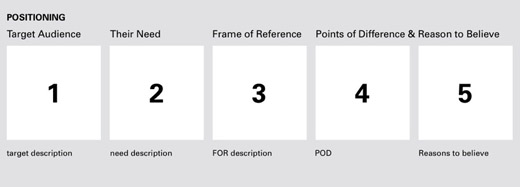
We’re now half-way through my mini-series on Brand Positioning Fundamentals. You’ll recall the key elements:
1. Your target customer
2. Their need
3. Their frame of reference
4. Your dramatic difference(s)
5. Your reason(s) to believe
In my last post, we covered the customer’s frame of reference. Let’s go a bit deeper here because it is especially easy to get this wrong if you are marketing a highly innovative or disruptive brand.
Take a look at the iPhone. When Steve Jobs introduced it what frame of reference could he have used? He could have invented any term for the frame of reference and the fanboys would have internalized it instantly. Internet Telephone Device? Web Handset? Superphone? What term did Apple use? The video below makes it pretty clear.
The iPhone Frame of Reference
Apple took great pains to make the frame of reference the dumb old “phone”, showing 70+ years of cinema stars answering them. Apple understood that using the phone as a frame of reference made the device instantly familiar to the masses. Notice that they didn’t use a frame of reference for their fanboys. They were focused on the mass market opportunity. Too many innovators overlook this most basic piece of brand positioning hygiene – focusing on the right target audience.Was that it then? Decided and done? No. As mentioned in previous posts, brand positioning must be ready to change with the competition, the market and the customer. When the iPhone as familiar phone-like object was successfully embedded in the minds’ of the masses, the company then expanded its’ frame of reference to include browsing the web, email, music, applications, and much more.
Motorola Droid Frame of Reference
Jump ahead three years to the recent launch of the Motorola Droid. As previously posted, I’ve intuited the droid brand positioning at launch to be:
For the technology leader who needs the latest and greatest device, the Motorola Droid is the iphone killer, with a giant screen and the ability to run multiple applications with ease.
But without getting into the semantics of artificial life, I think they are simply saying they made a phone that kicks iPhone butt. (comments welcome).
This is something Blackberry or Windows Phones don’t have the feature set to do, but the Droid does. If you really can take on the number one player, and their brand is ubiquitous like the iPhone, you can make them your frame of reference with brilliant results.
Palm Pre – Missed positioning opportunity
Sadly, this is a tactic Palm could have taken with the Pre. Instead, their frame of reference was just like Apple but two years too late: the plain old phone. And now, as the Droid grabs mind share with their strategic brand positioning, Palm, Windows, Blackberry and other smartphone players are getting pushed down the brand ladder, while the Droid gets comfortable (at least for now) in the number two customer loyalty spot behind the iPhone.
Brand Positioning is not some abstract concept. It is a set of simple, plug and play rules that you can ignore or exploit to your advantage.
Ask yourself (Especially if Your Brand is Innovative):
- Is my frame of reference designed for my target audience?
- Is it instantly familiar and orienting?
- Am I missing a massive brand positioning opportunity? One where I could use a ubiquitous competitor as a point of reference, and in so doing slingshot my brand into greater awareness?

